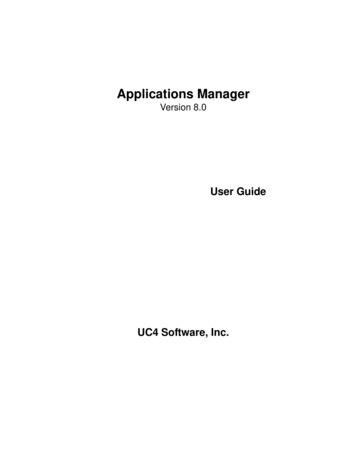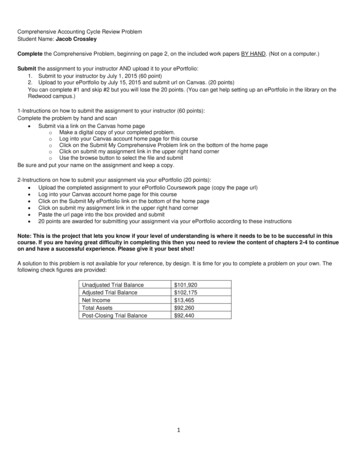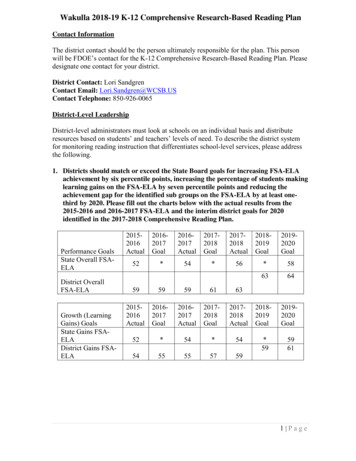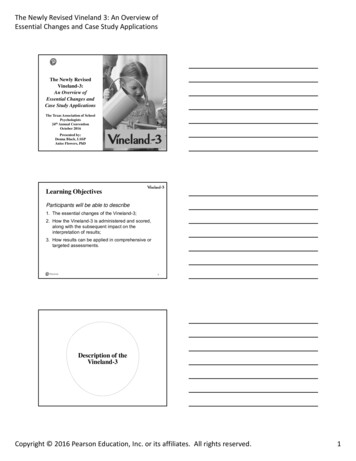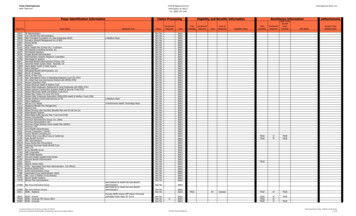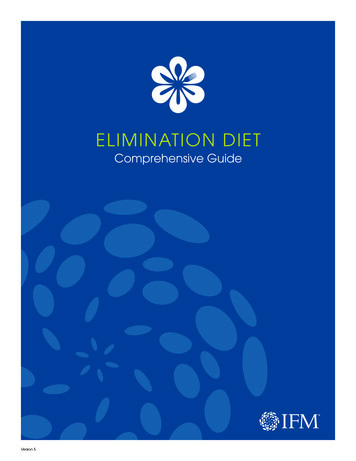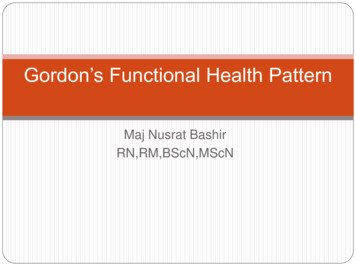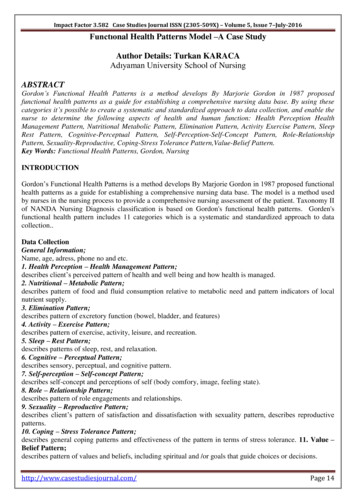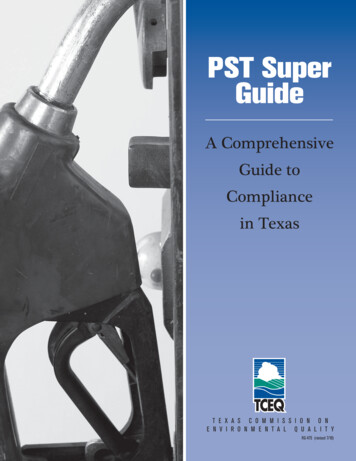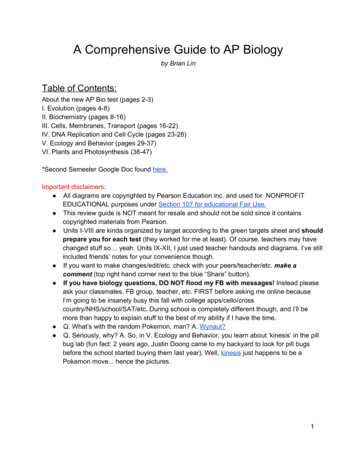
Transcription
A Comprehensive Guide to AP Biologyby Brian LinTable of Contents:About the new AP Bio test (pages 2- 3)I. Evolution (pages 4- 8)II. Biochemistry (pages 8- 16)III. Cells, Membranes, Transport (pages 16- 22)IV. DNA Replication and Cell Cycle (pages 23- 28)V. Ecology and Behavior (pages 29- 37)VI. Plants and Photosynthesis (38- 47)*Second Semester Google Doc found here.Important disclaimers: All diagrams are copyrighted by Pearson Education inc. and used for NONPROFITEDUCATIONAL purposes under Section 107 for educational Fair Use. This review guide is NOT meant for resale and should not be sold since it containscopyrighted materials from Pearson. Units I- VIII are kinda organized by target according to the green targets sheet and shouldprepare you for each test (they worked for me at least). Of course, teachers may havechanged stuff so yeah. Units IX- XII, I just used teacher handouts and diagrams. I’ve stillincluded friends’ notes for your convenience though. If you want to make changes/edit/etc. check with your peers/teacher/etc. make acomment (top right hand corner next to the blue “Share” button). If you have biology questions, DO NOT flood my FB with messages! Instead pleaseask your classmates, FB group, teacher, etc. FIRST before asking me online becauseI’m going to be insanely busy this fall with college apps/cello/crosscountry/NHS/school/SAT/etc. During school is completely different though, and I’ll bemore than happy to explain stuff to the best of my ability if I have the time. Q. What’s with the random Pokemon, man? A. Wynaut? Q. Seriously, why? A. So, in V. Ecology and Behavior, you learn about ‘kinesis’ in the pillbug lab (fun fact: 2 years ago, Justin Doong came to my backyard to look for pill bugsbefore the school started buying them last year). Well, kinesis just happens to be aPokemon move. hence the pictures.1
About Me. and the new AP Bio test.My name is Brian Lin, if you don’t already know me, then you sure will 70- 80 pages later.Anyways, I like playing the cello, fooling around, and complaining about things in review guides.So have fun, learn a lot, and eat a lot (the pre- AP test breakfast is AMAZING!) However, don’t eatso much that you end up throwing up during the test and losing time (one of my friends lol).On the AP Bio Test.Alright, so my year (2014) got kinda screwed over. they happen to be changing the AP Bio andAP Chem tests the year we take them. Oh well. that’s life, isn’t it? Anyways, you can see foryourself how the AP Bio test went last year:The mean went up, but the percentage of 5s went down(down down down down.).DO NOT BE WORRIED! I will explain below whathappened and what you can do to be prepared!Now here’s what the graders/College Board had to sayabout this (typos included):1,200 college students were administered redesigned AP Biology exam questions this spring;; their workwas scored at the AP Reading. College professors also took the full redesigned AP Biology examthemselves & evaluated each question to set the pts needed for 2,3,4,5. Most AP Biology students earnedenough pts to get a 2,3,4, but very few scored well enough on the grid- ins and free- response to score a 5.AP Biology grid- in questions require students to use mathematics to solve biological problems. The avgscore on these was very low: 36%.Multiple- choice: last year, students earned 63% correct on average;; this year, 61%FRQs require students to "explain," "describe," "justify" their content knowledge. Very low scores onavg.ow.ly/mmH0O. What % of AP Bio students earned 0 pts on these FRQs? Q5 (polypeptides): 45%. Q6(organelles): 49%. Q8 (hormone- signalling): 54%. AP Bio students performed well on Q3 (evaluating fossilsof a transitional species) and Q7 (effect of alcohol on urine production).I have posted a 6- page summary of the AP Biology exam results on the AP Biology Teacher Community.College professors attest that AP Biology cousre & exam are now the gold standard in college- level Biology.Kudos to AP Biology teachers.Previously, the free response questions (FRQs) were only 25% of the total score. Now, theFRQs make up 50% of the total score. And if you combine that with the fact that 50% ofstudents got 0s on about half of their FRQs, there you go. So, my explanation for the drop in 5sis that kids in other schools (aka not Stevenson) had NO CLUE how to write FRQs.FRQ tip: Points are cumulative only! Therefore, you can have tons of incorrect stuff but theycan’t take points off for that (obviously, this is different on other AP tests).“Somehow, maybe just due to the stress of the test, kids saw that message, and thought the2
proctor would tell them when to move on to the grid- in problems. So time ran out, and they didn'tdo them!” - Some teacher guyApparently some people just didn’t do the grid- ins because I have no idea really. Luckily, all ofus were told to work backwards on the MC, starting with the grid- ins (and the hardernormal MC) so I (at least) did not have that problem. Grid- ins are not really that hard though.Even though you can’t guess like a MC question, there’s quite a bit of room for rounding errorsand stuff. And the math is pretty easy (though tedious).Also, time was not an issue for me (that’s for me though, one of my friends had to throw up inthe middle and didn’t finish ). I had enough time left after the MC to check over about half ofthem. On the FRQs, I was able to read through all of them (and my responses). In fact, makesure you leave plenty of space to add stuff later since you will have time to go back and stuffmore key words in.Also, it’s important to realize that the test has shifted away from memorization/content- basedand more towards skill/application/understanding (for example, they will have questionswhere they will explain a lab/concept for you and then ask you about it). Your teachers will saycorny stuff about how understanding stuff is important (the whole Big Idea thing).They’re actually right. Seriously, I thought it was really cheesy but it helped A LOT.Big disclaimer here: The AP Biology test content NO LONGER coincides (completely) withthe SAT Bio test. You will have to self study around half of the material. Sucks since theCollege Board makes both but haven’t updated the SAT subject test. Also, there’s a lot lesscurve than physics, which sucks. Take SAT PHYSICS or CHEM! Please! (Plus Princetondoesn’t take Bio for engineering majors). Seriously, I regret not taking SAT Physics.Also, do not pay for test- prep books/ tutoring unless they’re based on/have actuallytaken the new test. I bought the Barron’s book last year and it was a waste of moneyconsidering entire chapters were irrelevant (and useless) and covered stuff we didn’t need toknow (all the while leaving other stuff out). Just ask someone who took the new test.Reasons Why You Shouldn’t Be Scared All three teachers are very qualified (from personal experience friends’ experience)A lot less homework than before (notes are not mandatory- more college style)Teachers/we now know what to look out for (no old tests to look at)I think David Chen got like a 100% on the 1st semester final. That should inspire you.The test was ‘easier’ but the curve was a lot tougher. This should be fixed (I hope).The percentages do not reflect Stevenson! You will be fine if you work hard!3
I. Evolution1. Evolution by Natural Selection Okay, let’s start off with a population (bunch of same species in same place) There’s going to be genetic variation. Why?1. Random mutations. Point mutations (insert/delete/frameshift)2. Crossing over and recombination (getting back together)3. Law of Independent Assortment (Metaphase I 2 dif. orientations)4. Random fertilization(You learn about all this stuff later, I just added it here since this is a big FRQ topic) These different individuals will be selected for or against by selective pressures Any developed traits that help you survive are known as adaptations Those that survive to reproduce will create offspring and change the allele frequency of thepopulation in favor of the ‘fit’ allele (allele version of a gene) Divergent evolution branching out (becoming “more different”) Convergent evolution evolving similarly (explains analogous structures in 5.) Population a group of individuals of same species that can interbreed and create fertileoffspring (so a herd of deer or something) Species a group of populations whose members can interbreed and produce fertile offspring(all the deer herds in the world)2. Hardy- Weinberg What’s it say? Allele frequency and genotype frequency remain constant! But for this to apply, we’ll need 5 conditions:1. Really big population/sample size2. No mutations3. Random mating4. No natural selection5. No migration/gene flow (ie no adding/removing organisms)Equation 1:P Q 1Equation 2:P ² 2P Q Q² 1P is the dominant allele frequency. Q is the recessive allele frequency.So if you have mice that can either have brown hair or black hair (where hair color is the genewith 2 different alleles). Then % brown (P) % black (Q) 100% (1). Should make sense.4
P² is the frequency in the population with homozygous dominant allele.2PQ is the frequency in the population with heterozygous both alleles.Q² is the frequency in the population with homozygous recessive allele.Since the mice get one allele from each parent, you multiply the allele frequencies together.Since P chance of getting the dominant allele and Q chance of getting the recessive allele,you multiple P * P to get the chance of getting homozygous (2) dominant alleles and so on. Genotype Set of genes it carries;; 2 alleles. Phenotype Expressed traits;; characteristics. (Straight hair)So if brown is dominant, a brown mouse can have the genotype Bb (one brown and one black)but still have the phenotype brown since that allele takes over.3. Microevolution What is microevolution? Changes in allele frequencies within a population. There are 4 main causes for microevolution:1. Random mutations2. Natural/Artificial Selection3. Genetic drift4. Gene flow Genetic drift is changing allele frequencies by changing the sample size1. Bottleneck (natural disaster random drop in gene pool, depends on survivors)2. Founder (random group leaves and ‘founds’ new population, depends on founders) Gene flow and migration is when you transfer alleles from one population to another4. Macroevolution What is macroevolution? Formation of a new species (speciation) How does this happen?1. Start off with parent species2. Add a reproductive barrier3. Wait some time4. Divergent groups can’t produce fertile offspring5. Voilà! Macroevolution There are two main modes of speciation Allopatric speciation geographic/physical isolationExamples would be mountains, long distances, oceans, etc.5
Sympatric speciation non- physical isolationExamples would be all the stuff in I.6: Reproductive Barriers (scroll down 1 page) Adaptive radiation refers to when a parent species diversifies and fills many different niches5. Evidence for Evolution Embryology stuff looks the same as an embryo and early stages of development Anatomy (what stuff looks like) Homologous structures (different function, similar anatomy) Vestigial structures (random crap left over from common ancestor, ex. tailbone) Analogous structures (NOT evidence, stuff that evolved same, bird/bug wings) Molecular Biology all organisms have similarities in DNA, RNA, proteins, ATP use, etc. Usebioinformatics to compare chimpanzee DNA to human DNA Paleontology dig up stuff, do carbon dating, look at fossil records, ratio Carbon 14 to 12 Physiology similar processes and functions in organisms (jaw bones, chloroplasts, etc.)6. Reproductive BarriersEgg Sperm Zygote Pre- zygotic impede mating or hinder fertilization even if mating occursType 1: No mating (ie NO SEX!) Habitat Isolation: different areas (water/land snake) Temporal Isolation: different times (winter/summer skunk) Behavioral Isolation: different courtship rituals (bird songs)Type 2: No fertilization (sperm never meets egg) Mechanical Isolation: the ‘parts don’t fit’ (use your imagination) Gametic Isolation: sperm cannot fertilize egg (dif. color eggs in sea urchins) Post- zygotic prevent the hybrid (offspring) from developing correctly Reduced Hybrid Viability: too weak and dies Reduced Hybrid Fertility: sterile offspring (mule) Hybrid Breakdown: hybrid’s offspring can’t survive6
7. Modes of Selection Directional favors one extreme Diversifying/Disruptive favors both extremes Stabilizing favors the middle Frequency Dependent fitness declines if too common (ex. Google ‘scale eating fish’) Sexual Selection organisms with best traits get to reproduce Intrasexual: compete with same gender (ex. alpha lion) Intersexual: ‘mate choice’ (choose flashy colors of peacock, etc.)8. Chi- SquareX ² Σ (O E)²E X² means “chi- squared”. DO NOT take the square root or anything. O means observed number E means expected number Degrees of Freedom number of possibilities minus one (ex. rolling a die 5 degrees offreedom) P value probability observed results are due to chance If P .05 results are NOT due to chance Null hypothesis predicting that there is NO change7
9. Cladograms/Phylogenetic Trees“Jaws, lungs, etc.” are traits that distinguish each branch. Clade bunch of organisms evolved from same common ancestor There are different types of clades Monophyletic: complete, all from same common ancestor (all the animals above) Paraphyletic: incomplete, not everyone (just the chimp, mouse, and pigeon) Polyphyletic: different common ancestor (all the animals above a plant)II. Biochemistry1. BondsNote: Bonds are listed in order of strongest weakest Intramolecular Bonds hold a single molecule together, covalent and ionic bonds Covalent Bonds a sharing of valence electrons Nonpolar (equal b/w two of same atom): O2, H2, etc. Polar (unequal sharing, difference in electronegativity): H2O Ionic Bonds giving or taking electrons Need a big difference in electronegativity (NaCl) Cation donates electron, Anion receives Intermolecular Bonds attraction between multiple molecules Hydrogen Bonds attraction between positive (H) and negative (O) poles of water molecules Van der Waals temporary dipoles from random electron movement, need to be closetogetherSo. Covalent Ionic Hydrogen Van der Waals8
2. Why is Water so Special? Structure polar molecule, easily forms H- bonds, hydrophilic of course 4 awesome properties:1. Cohesion: Water molecules link together with H- bonds, allows for transpiration pull in plants2. Moderation of Temperature: High specific heat takes a lot of heat to increasetemperature, evaporative cooling (sweating), regulates the Earth’s climate3. Freezing: ice floats on water, keeps fish and stuff alive, oceans can thaw out duringspring/summer4. ‘Universal Solvent’: forms aqueous solution3. Acids and Bases Acid Donates H ions Base Accepts H ions (increases OH concentration) Strong acids/bases dissociates completely in water (completely falls apart)ex. HCL H and Cl- Weak acids/bases ionically binds and stuff, does not dissociate completelyex. H2CO3 H HCO3 Carbonic Acid Hydrogen Ion Bicarbonate IonNotice how you get the random clump of crap (Bicarbonate Ion) pH scale measures how acidic or basic a solution is Acids pH 0- 7 Bases pH 7- 14 Go up 1 number multiply by 104. Carbon and its Isomers Carbon has 4 valence electrons equal as likely to give or receive Isomer same chemical formula, different physical arrangement of atoms Structural different covalent bond arrangements, always single bonds Geometric double bonded in center (can’t move), X/H can rotate in 3DCis: 1st example, Trans: 2nd example (trans across, like trans- continental) Enantiomer same arrangement of atoms, but are ‘mirror images’ of each other, always intetrahedral shape (3D), also known as “chiral compounds”9
5. Functional Groups10
(Make sure to refresh on these before the AP test/final)11
6. Macromolecules Dehydration synthesis take out a water molecule, combine two things (anabolism) Hydrolysis add a water molecule, break things apart (catabolism) 4 groups of macromolecules Carbohydrates, lipids, proteins, nucleic acids Notice that maltose does not follow the 1:2:1 ratio as it loses 2 hydrogens and 1 oxygen in therelease of a water molecule Carbohydrates C, H, O 1:2:1 ratio, sugars end in - ose Monomer Monosaccharides Type of covalent bond glycosidic linkagesFor energy purposes: Monosaccharides: single sugar (glucose, fructose, ribose, deoxyribose) Disaccharides: double sugarSucrose: glucose lactose (sucrose table sugar)Maltose: glucose glucose (amylase breaks down starch maltose)Lactose: glucose galactose (sugar found in milk) Polysaccharides: multiple sugars, used for energy storageStarch in plants (don’t move, can store energy long term as carbs)Glycogen in animals (short term storage, fat is for long term)For structural purposes: Chitin: forms the exoskeleton of arthropods (crabs, bugs, etc.) and fungi cell walls Cellulose: plant cell walls Lipids insulation long term energy storage Monomer Fatty acids, glycerol, other stuff Type of covalent bond Ester linkages Saturated fats: solid at room temperature, 3 fatty acids glycerol Unsaturated fats: liquid at room temperature;; 3 fatty acids glycerol Steroids: 4 carbon ring things with functional groups Phospholipids: polar head (phosphate) and nonpolar tail12
(fatty acids)2 fatty acids glycerol phosphatePhospholipid bilayer in semi- permeable membranes Waxes: long fatty acid alcohol Proteins do a ton of stuff Monomer Amino acids (20 different) Type of covalent bond Peptide bond Functions: Structure (keratin, collagen) Transport (hemoglobin) Enzymes (amylase, lipase, polymerase, etc.) Defense (antibodies, cytokines, etc.) Hormones (insulin) Motion (actin and myosin in muscles) 4 Levels of Protein Structure1. Primary Structure (polypeptide chain of amino acids linked by peptide bonds)2. Secondary Structure (folding between polypeptides, linked by Hydrogen bonds)Forms Alpha helices and Beta pleated sheets3. Tertiary Structure (bonds between R- groups, forms 3D shape)Ionic bonds/ Salt bridges from acidic (- ) and basic ( ) R- groupsHydrogen bonds (between - COOH and - NH2 and - OH groups on side chains)Hydrophobic forces between non polar side groupsDisulphide bridges (strong covalent bonds b/w sulfhydryl groups in thiols)4. Quaternary Structure (not necessary, interaction between multiple subunits) Nucleic Acids (Note: Nucleic acids may no longer be in this unit) encoding, transferring,and expressing genetic information Monomer Nucleotides (phosphate pentose nitrogen base) Type of covalent bond Phosphodiester bonds Two types of nucleotides: Pyrimidines: 1 carbon ring nitrogen bases (cytosine, thymine/uracil) Purines: 2 carbon rings nitrogen bases (adenine, guanine)13
14
7. Enzymes and Regulation Enzymes protein catalysts;; lower the activation energy needed for a reaction to take place Enzymes are reusable. Enzymes bind to specific substrates. Lock and key model: specific substrate for specific enzyme, binds to active site Induced fit model: more accurate, the substrate induces (causes) the enzyme to alignwith the substrate (not a perfect fit) Denaturing temperature/salt/pH break apart bonds in secondary/tertiary structure For example, if you have an acid such as Hydrochloric acid (HCl), it might interrupt theH- bonds of the secondary structure, causing everything to fall apart Also, raising the temperature can denature enzymes because of either:1. Going beyond the optimum enzyme temperature (when enzymes are mostefficient)2. Adding heat which raises the kinetic energy of the enzyme to the point thatbonds begin falling apart Cofactors non- protein helper for enzymatic reactions Inorganic minerals (zinc, iron, copper, etc.) Organic coenzymes (vitamins, etc.)15
Enzyme regulation in addition to active site, enzymes also have allosteric sitesIII. Cells, Membranes, and Transport1. Surface Area to Volume Ratio The greater the SA:V ratio is more efficient because more ‘stuff’ can pass through Smaller the cell higher the SA:V ratio better2. Cell Organelles Eukaryotes can have golgi apparatus, mitochondria, vacuole, chloroplast (plants only), cellwall (plants, fungi, etc.), nucleus, ribosomes, endoplasmic reticulum, cytoplasm, cytoskeleton,plasma membrane Prokaryotes can have ribosomes, cytoplasm, nucleoid, plasma membrane, cell wall, capsule16
3. Organelle Interaction Let’s follow a protein pathway. For our purposes, the protein has already been synthesized.The process of protein synthesis will be covered in VIII: Protein Synthesis Proteins are synthesized in ribosomes. Free ribosomes are found floating around in thecytoplasm while bound ribosomes are stuck to the rough endoplasmic reticulum. Rough- ER bound ribosomes Protein is synthesized in ribosome Enters lumen (area within the entire ER) Chaperonin (protein) folds new protein in secondary and tertiary structure Protein travels to Smooth- ER (parts of ER without ribosomes) Buds off in a transport vesicle towards the Golgi Within the Golgi, travels in cis to trans direction At cis end, enzymes will begin modifying protein by phosphorylation or glycosylation Glycosylation adds/removes sugars. This decides where the protein will go At trans end, the finished protein will exit the Golgi in secretory vesicles If the vesicles fuse with lysosomes, the proteins will be for digestion of stuffProtein examples: Nuclease, lipase, protease, etc.Stuff examples: Food, antigens, screwed up organelles, etc. These vesicles can also carry the proteins out or to other organelles The proteins will leave the cell and enter the bloodstream via exocytosis Examples of RER proteins include: hormones (insulin) and digestive enzymes (lipase) Free ribosomes Protein is synthesized in ribosome Receive little amount of modification (compared to RER proteins) Still fold into tertiary structure by chaperonin in the cytosol Cytosol: glycolytic enzymes, Actin for microfilaments (in cytoskeleton, muscles, etc.) Nucleus: histones, transcription factors, etc. very important! Mitochondria and ChloroplastThese organelles actually have their own genome and protein factoriesStill import most integral proteins (electron transport chain, etc.) from cytosol Always inside the cell it was produced in!17
4. Prokaryotic vs. Eukaryotic Cells Prokaryotes include domains Archaea and Bacteria (E. coli, mold, etc.) Eukaryotes include domain Eukarya (echinoderms, chordates, plants, etc.)18
5. The Three Domains of Life6. Origin of Life Abiotically synthesize small organic molecules (amino acids, hydrocarbons, etc.) Miller- Urey experiment“Primordial soup” of methane, ammonia, water, hydrogen, energyNO oxygen present in large amounts (not until plants spread) These molecule form big macromolecules (proteins, carbs, lipids, nucleic acids, etc.) Formation of protobionts (membrane- enclosed molecules) RNA World RNA can replicate, pass down inherited traits (like DNA) RNA can also act like an enzyme as a ribozyme Endosymbiosis membrane bound prokaryotes engulf each other, mutually beneficial More efficient (compartmentalized processes) Chloroplasts/mitochondria have own genome, proof for endosymbiosis19
7. Parts of a Plasma Membrane Peripheral proteins located on the hydrophilic surface of membrane, responsible forregulating cell signaling, interaction, and other events Integral proteins embedded within membrane, serve as pumps, channels, and electrontransport chains Cholesterol located within the hydrophobic regions, maintains membrane stability whenwarm, maintains fluidity when cool Glycolipids carbohydrate (glyco- ) bound directly to membrane (lipid), provides energy,cellular recognition, Glycoproteins carbohydrate (glyco- ) bound to a membrane protein (usually peripheral), cellsignaling, determine blood type, recognition of self vs. nonselfGlycolipids Glycoproteins Glycocalyx Immune system can recognize and attack foreign (nonself) organisms Immune system can recognize and attack cancerous cells Transplant issues20
8. Types of Passive Transport Concentration Gradient substances, molecules, ions, etc. will naturally travel from highconcentrations to low concentrations Diffusion simply going down the concentration gradient Osmosis the diffusion of water down its concentration gradient (from high water potential tolow water potential) Facilitated Diffusion still going down the concentration gradient, but traveling through anintegral protein channel (ex. ‘leak’ channels for K ions)9. Types of Active Transport The cell spends energy (ATP) to send stuff against its concentration gradient Proton pumps pump ions in or out of a cell in order to establish a concentration gradient Cotransport pump H ions, other ions or molecules hitch aride10. Types of Bulk Transport Exocytosis create a vesicle to send stuff outside of the cell Endocytosis vesicle meets membrane and enters the cell todeliver contents21
IV. DNA Replication and Cell Cycle1. Scientists and DNA Griffith Experiment1. Live smooth bacteria mouse mouse dead2. Live rough bacteria (no protective coat) mouse mouse alive3. Heat killed smooth bacteria mouse mouse alive4. Heat killed smooth bacteria live rough bacteria
College professors attest that AP Biology cousre & exam are now the gold standard in college level Biology. Kudos to AP Biology teachers. Previously, the free response questions (FRQs) were only 25% of the total score. Now, the FRQs make up 50% of the total


